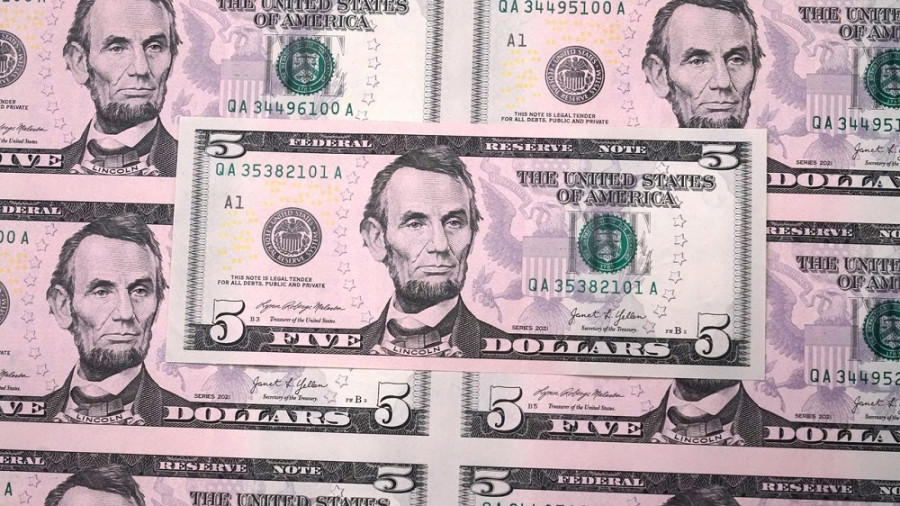
The EUR/USD pair ended the trading week at 1.0893. The buyers did not win the weekly round as they failed to hold their positions within the 9th figure. The attempt to breach the 1.10 figure also fell short, with traders only spending a few hours above the 1.1000 mark. Towards the end of the week, the initiative shifted to the sellers who took advantage of the prevailing situation (rise in risk-off sentiment and contradictory statements from the Federal Reserve chair). However, it is not appropriate to speak of a trend reversal at this point. Undoubtedly, the greenback may still show strength, benefiting from its safe-haven status. However, such emotional fundamental factors typically have short lifespans. Meanwhile, in the medium and long term, buyers have a better chance of turning the situation in their favor, even despite the disappointing PMIs published on Friday.
Two-faced PowellThe key event of the past week was the speech of Fed Chair Jerome Powell. He first presented the semi-annual report in the House of Representatives, followed by the Senate. Throughout his speeches, he tried to strike a certain balance in his rhetoric, and judging by the dynamics of the U.S. dollar index, he succeeded.

Initially, the Fed chair dealt a verbal blow to the greenback, but then partially restored its position by adopting a more hawkish tone. While responding to questions from congressmen in the House of Representatives, he said that the Bank had "gone far enough in raising rates, and at a rapid pace," thus necessitating a pause for reassessment. At the same time, he said that the current cycle of monetary tightening was nearing its end. Such soft formulations did not sit well with dollar bulls: the U.S. dollar index hit a six-week low, and the EUR/USD pair tested the 1.10 figure for the first time since the beginning of May. However, subsequent events prevented bulls from solidifying above the 1.1000 target. Although the outcome of the June FOMC meeting, the "red hue" of U.S. inflation, continued inflationary pressure in the eurozone, and the hawkish stance of the European Central Bank all contributed to the development of an upward movement.
But Powell, who had seemingly undermined the dollar the day before, came to its aid. The second part of his Senate speech had a more hawkish tone. He emphasized that inflation in the U.S. remained at an unacceptable level, as price growth, although slowing, was still far from target indicators. Therefore, the Fed had no other choice but to raise rates going forward. He also allowed for two rate hikes by the end of 2023 ("it would be appropriate to raise rates again this year, perhaps twice").
Ultimately, based on the outcome of his two speeches, Powell managed to maintain a hawkish stance while simultaneously announcing the end of the current cycle of monetary tightening. Such "duality" from the Fed chair helped the dollar stay afloat. According to data from the CME FedWatch Tool, the probability of a 25 basis point rate hike at the July meeting currently stands at 72%. It is worth noting that the likelihood of maintaining the status quo at the September meeting (assuming a rate hike in July) is estimated at 65%.
Risk-off sentiment + PMIOn Friday, the situation improved for the dollar due to increased risk-off sentiment (declining U.S. bond yields and losses on Wall Street signaling safe-haven outflows, along with the infamous Friday factor). Meanwhile, the situation worsened for the euro. Preliminary PMIs for June disappointed buyers as they remained in the contraction zone, falling short of forecasted levels, and in some cases, significantly so. For example, Germany's manufacturing sector PMI plummeted to 41 (forecasted to decline to 44), marking the weakest result since May 2020. The equivalent eurozone-wide index also entered the contraction zone, dropping to 43. PMIs in the services sector decreased both in Germany and the broader European region.
Amid increased risk-off sentiment, this data added pressure on EUR/USD, causing the pair to finish the week around the 1.08 level.
Conclusion:In my opinion, the pair will continue to fall towards the support level at 1.0805 (where the lower band of the Kumo cloud coincides with the middle line of the Bollinger Bands indicator on the daily chart). However, the bearish correction will only be sustained by risk-off sentiment. Once risk appetite increases again, EUR/USD bulls will return to their previous positions, targeting both the 1.09 level and the resistance level at 1.1000.
After all, the Fed chair's rhetoric still had a "conclusive" character (despite its situational hawkishness): in particular, he said that the central bank is close to its goal, it makes sense to proceed with extreme caution, and "overdoing" rate hikes is not advisable.
On the other hand, the ECB demonstrates a more hawkish stance, despite the decrease in consumer price index in the eurozone. ECB President Christine Lagarde explicitly announced a rate hike in July and allowed for further steps in that direction.
From a technical standpoint, on the daily chart, the EUR/USD pair is within the Kumo cloud, above the Tenkan-sen and Kijun-sen lines, and between the middle and upper lines of the Bollinger Bands indicator. Since you should only consider long positions once the bulls return to the 1.09 level, specifically surpassing the target of 1.0940 (upper band of the Kumo cloud on the daily chart). In that case, the Ichimoku indicator will generate a bullish "Parade of Lines" signal. Furthermore, such dynamics would indicate that bears failed to expand their success and hold their positions. In that case, the initial and current main target for the upward movement would be the 1.1010 level (upper line of the Bollinger Bands indicator on the four-hour chart).